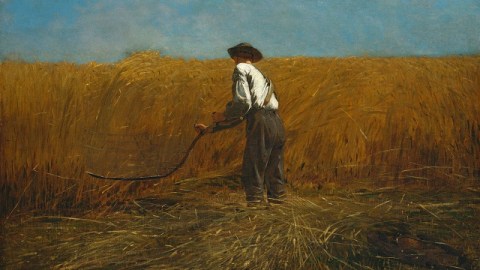Why Civil War Art Is Self-Defeating

Among the many things about America that the American Civil War changed was its art. Painting and sculpture simply couldn’t be the same. In these sesquicentennial years, every aspect of that conflict finds itself under the critical microscope. The Civil War and American Art, which runs through September 2, 2013 at The Metropolitan Museum of Art, New York, succeeds in demonstrating the fascinating failure of American art to express the horror of the Civil War. Still trapped in the throes of Romanticism and not yet ready for the prime time of Modernism, American art couldn’t possibly succeed. The Civil War and American Art proves once and for all why Civil War art is self-defeating.
Met Director and CEO Thomas P. Campbell simultaneously describes and defends the exhbition by saying that, while “it has fallen to history museums to organize exhibitions about wars,” that’s not what you’ll find here. “[T]he works of art in this exhibition—which include some of the greatest examples of their era—were not intended to document the war,” Campbell continues. “Rather, they chronicle how genre painters, landscape painters, and photographers responded to the coming of the war, the fact of the war, and its aftermath, and how the war changed American art.” So, The Civil War and American Art is more about mood than facts—art as truthiness. For an event so steeped in places, names, and events—just the facts, ma’am—the art surprisingly turned away and told the truth “slant,” as Emily Dickinson wrote. But was that slanted view enough then, or now?
Landscape painting before the war excelled in expressing evocative feelings. The Hudson River School established the first real American art movement by adapting European Romanticism to the uniquely American landscape. Martin Johnson Heade’s Approaching Thunder Storm (from 1859) screams ominousness so loudly, it should have a soundtrack by Bernard Herrmann. The exhibition uses Heade’s painting as an emblem of “the nation’s mood,” but absent all historical context, is it really anything more than figures dwarfed by a darkening sky reflected in a darkening lake? The years preceeding the start of hostilities were dark, but are we reading in hindsight what we want to be a contemporary response? Similarly, Sanford R. Gifford’s A Coming Storm (1863) possibly paints the dark national mood onto canvas via a landscape scene. Gifford actually served in the Union Army, which improves the odds of a connection, but what makes the painting even more ominous (or infamous) was its ownership by Edwin Booth, brother of Abraham Lincoln’s assassin John Wilkes Booth. These extraneous factors contribute so powerfully to Gifford’s Storm that it’s hard to see the painting itself. But it’s also hard to imagine how The Hudson River School could learn to deal frankly with the reality of war and remain on speaking terms with nature.
The failure of American painting to communicate the war while still trying to depict it appears most clearly in Frederic Edwin Church’s Our Banner in the Sky. Painted in 1861 in response to the Confederate attack on Fort Sumter that began the Civil War, Our Banner in the Sky arranges a red sunrise, white clouds, and starry blue sky into a American flag, complete with eagle soaring patriotically across the scene. There’s something surreal about Church’s natural flag, but even that point of interest dissipates in the saccharine sentiment. The feathery clouds mimic the tattered fabric of the Fort Sumter flag, which Union forces valiantly protected to the end, and, by extension, the now tattered fabric of the American experiment itself. Church, a masterful Hudson River painter, could transport you to the Andes, make a cathedral of the wilderness, or drift you down a tropical river of light, but failed imaginatively to picture a war. Perhaps the very nature of the Hudson River School and its visual Transcendentalism doomed it from stooping to the gritty facts of wartime from the start.
The Civil War, as Ken Burns’ monumental series proved, was foremost about people. The Hudson River School and almost all of 19th century landscape painting presented people as insignificant in the face of a pantheistic, romanticized natural setting. The best Civil War painting (like the best Civil War photography, which I’ll get to in a minute) featured the people involved. The Civil War and American Art actually does a pretty good job in rediscovering the usual missing persons from such exhibitions.
Eastman Johnson’s A Ride for Liberty—The Fugitive Slaves, March 2, 1862 plays up the melodrama Uncle Tom’s Cabin style, even though Johnson claimed to have based it on an event he witnessed. But even melodrama’s progress over the racially stereotyped images of African-Americans that continued through the war years (and beyond). Even better than Johnson’s riders are Winslow Homer’s The Cotton Pickers. Painted a decade after the Civil War’s end, The Cotton Pickers shows two African-American women in the field as beautifully and naturally human as two women of Brittany.
The other usual group of missing persons from any Civil War art exhibition is the Confederates. History’s written by the winners, so art history usually gives priority to the Northern side. Conrad Wise Chapman’s The Flag of Sumter, October 20, 1863, tells the other side of the story from Church’s surreal flag by featuring the Confederate flag flying resolutely over Fort Sumter after Union attacks in 1863. Chapman’s not a bad artist, but he’s not in Homer, Church, or even Johnson’s league, which is one reason why it’s hard to find Civil War painting from the Southern side to fill such exhibitions. Including Chapman in this exhibition’s like including Henry Timrod, the “poet laureate of the Confederacy,” in poetry anthologies of the period—more than tokenism, but still not a level playing field.
The one painting that succeeds the best in combining old school Romanticism and classicism while still having a modern feel is what I believe to be the greatest of all American Civil War paintings and, perhaps, the greatest anti-war painting ever done by an American—Winslow Homer’s The Veteran in a New Field (shown above). Painted right after the war’s end in 1865, Homer shows a Civil War veteran picking up a scythe and getting back to work on his farm the moment he returns, as shown by his uniform jacket tossed aside. The golden grain before the farmer evokes the beauty of the landscape, while the reaping harkens to the Biblical beating of swords into ploughshares. And, yet, the scythe also calls to mind the Reaper, Death’s middleman. As much as the farmer wants to forget and go into a new field, death follows him. America wanted to forget the war, too, but never could shake the memory of self-slaughter over slavery, America’s “original sin.” It’s a type of willful blindness akin to the next great American anti-war painting, Gassed by pseudo-American John Singer Sargent. Sargent’s painting shows a string of World War I soldiers blinded by gas stumbling blindly across the landscape to symbolize the blindness of countries rushing off to war ignorant of the real human cost. Homer’s veteran knows the cost all too well, desperately wants to forget, but ultimately cannot.
The greatest anti-war painting of all time is, of course, Picasso’s Guernica, but that modernist idiom didn’t yet exist for Homer and his contemporaries to exploit. The Civil War and American Art shows these limitations while demonstrating how American artists (and the American public) struggled to understand a world changing quickly before them. Underlining in bold these limitations is the Met’s companion exhibition Photography and the American Civil War (which I wrote about here), which shows how the new technology of photography won the war for both documentation and mood over the older medium of painting. (A few photographs actually appear in The Civil War and American Art, as if photography couldn’t be held back from invading painting’s territory.) The Civil War and American Art illustrates clearly just how far the imagination could go at that place and time in painting. Never surrendering, these artists did their best with what they had, but they still never had a fighting chance.
[Image:Winslow Homer. The Veteran in a New Field, 1865. Oil on canvas. 24 1/8 x 38 1/8 in. The Metropolitan Museum of Art, New York, NY, Bequest of Miss Adelaide Milton de Groot (1876-1967), 1967, 67.187.131. © The Metropolitan Museum of Art, New York.]
[Many thanks to The Metropolitan Museum of Art, New York, for providing me with the image above and other press materials related to The Civil War and American Art, which runs through September 2, 2013.]
[ANNOUNCEMENT: I will be presenting a lecture titled “Art Made Personal: Chris Sanderson and the Wyeth Family” at the Christian C. Sanderson Museum in Chadds Ford, PA, on Sunday, June 23rd, from 1 to 3 pm. Please come out to support a great museum with a great collection of art and historical artifacts.]





